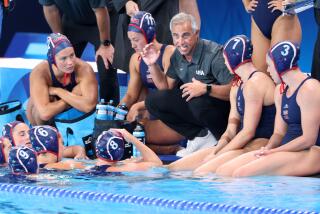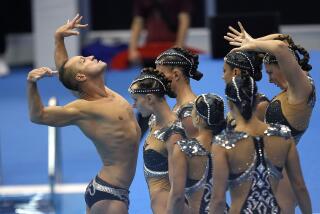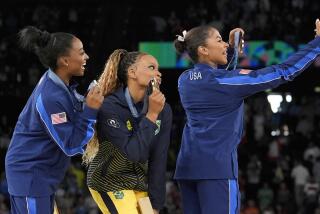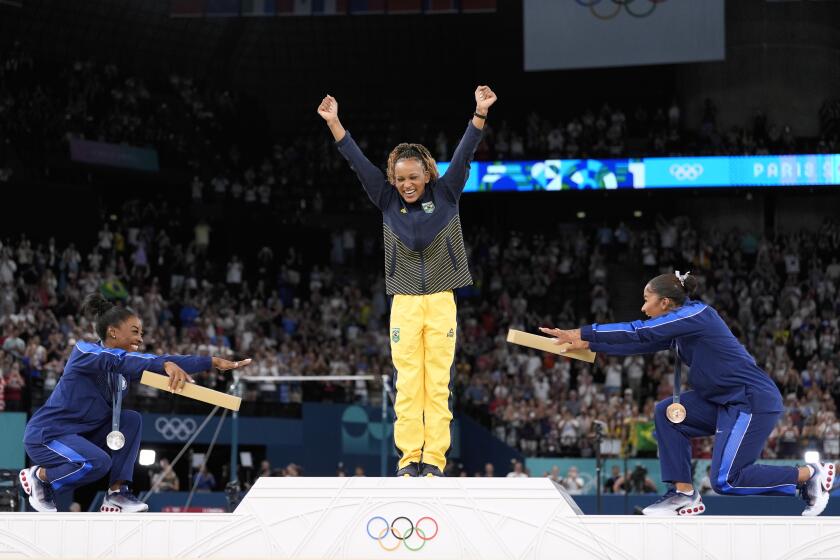A Touch Too Much : Harassment and More Are Possible When Men Coach Female Athletes
Olympic swimmer Mary T. Meagher knows how innocently it begins.
She was 16 and traveling with the national team. A male coach began to pay unusual attention to her.
“It started as a mutual flirt,” she said. “He was young and good-looking. Morning workout was optional and so I’d go and I’d be the only one. We’d stay after and talk a couple of hours.
“After the meet I noticed he was starting to put his arm around me. On the plane coming home he asked if he could sit with me. I was trying to go to sleep and suddenly I felt someone caressing my back. That was it. I changed seats.”
After Meagher returned home, the coach, who was one of several on the trip, telephoned her and invited her to move in with him. Meagher told her parents and they intercepted the next call and asked the coach not to call again.
The incident proved a valuable lesson to a young and still naive Meagher.
“It made me realize, No. 1, not to go too far with the flirting, and No. 2, never to put myself in a vulnerable place,” said Meagher, a three-time Olympian who was a triple gold medalist in the 1984 Olympics. “When I was young, I lived and died to please the coach. I think if a coach went over the border, I would have been confused. You just become emotionally attached.”
Where is that border? Not all coaches know where it is, but all know it’s there. It is the place where they move from professional to unprofessional behavior. When a touch becomes a caress.
“You have to be very professional and never cross that threshold,” said Zenon Barbraj, UCLA’s men’s crew coach, who has also coached women.
“There is no way back for a coach who crosses that line. It affects not only his relationship with that athlete but with the whole team. It’s an unspoken rule that you don’t get involved that way with your athletes. I’ve heard about it happening, though. It happens.”
There have been cases--charges of sexual assault, sexual harassment, sexual impropriety--involving male coaches and female athletes. Many are handled internally by a university or club. In some cases, athletic officials simply announce that a coach is resigning “for personal reasons.”
This careful wording makes it difficult to track the frequency of such cases because rarely is the impropriety specifically noted.
Loren Seagrave coached the women’s track team at Louisiana State. One night in July of 1988, according to Seagrave, one of his athletes called him and said she wanted to discuss a problem she was having with a boyfriend. Seagrave, who is married, said that because the young woman seemed so distraught, he agreed to meet her.
Seagrave and the athlete met that night in an empty house the coach owned. Although the two spent the night in the house, Seagrave said he merely comforted the woman and that there was no sexual contact.
Seagrave was fired in April of 1989 because of the incident, which was described by the university as being inappropriate. Seagrave has countersued LSU in a case that is pending.
Some sports have taken action to better define the borders of the coach/athlete relationship.
The American Swimming Coaches Assn. is in the midst of setting down ethical guidelines for coaches. The new standards, expected to be adopted in September, include a definition of appropriate behavior between coaches and athletes.
“How big a problem it is, we will probably never know,” ASCA executive director John Leonard said.
“Certainly there are legally documented cases and some cases that will never come to substantial light. We feel here that the very least you can do is establish a code of ethics that lays out what is correct and incorrect behavior.”
There is at least one place where such guidelines are spelled out clearly: state and federal statutes.
Most male coaches say they are very aware of the potential for problems and go out of their way to avoid even the appearance of improper physical contact.
Andy Banachowski, UCLA women’s volleyball coach, said he rarely even touches his players, lest it be misconstrued.
“I haven’t been a touchy-feely type,” he said. “I do make a point of not slapping anyone across the rear. A pat on the back is a pat on the back.”
But Frank Carroll, a figure skating coach, said touching is unavoidable in his sport.
“It’s dance on ice,” he said. “If someone is doing something wrong, you must straighten out their position and you must do it with your hands. In 27 years of coaching, I have had only one complaint from a parent. A father asked me why I had to put my hands on his daughter’s legs. I told him I didn’t appreciate his thoughts. I told him I couldn’t coach his daughter if I was inhibited. He took his daughter to someone else.
“It’s like ballet. Arms and legs are pieces of equipment. If they are out of whack, someone has to fix them. Sex doesn’t enter into it.”
The situation seems more acute at the college level, where the athletes are presumably more mature.
In the spring of 1991, Guy Enriques resigned after four years as coach of Oregon State’s women’s volleyball team. According to published reports, the team confronted Enriques and accused him of having an affair with one of the players. The players also turned over to the athletic department amorous letters written by Enriques to the player in question.
Dutch Baughman, Oregon State athletic director, would say only that Enriques, who is married, tendered his resignation for “personal reasons.”
Devin Mahony, a former coxswain for both the men’s and women’s crew teams at Harvard, calls the sexual tension sometimes present when men coach women “a very delicate game.”
“It’s foolish to say those dynamics can’t work well,” Mahony said. “There is a potential for damage, but it can be handled. I would say that I had strong emotional relationships with the men who coached me. But I went through eight to 10 years of that unscathed by any awkwardness or conflict.
“There are areas of emotional and intellectual vulnerability that a coach may manipulate, damage or misconstrue. That relationship is charged. It can be cruel. There shouldn’t be a sexual conflict-of-interest in athletics any more than there should be in a boss-employee relationship. It’s a professional relationship. If something develops, then the coach should not coach that athlete.”
What if the coach continues to coach the athlete, but marries her, too? That’s what happened to Jackie Joyner and Bob Kersee. Kersee was an assistant coach for the UCLA women’s track team, Joyner was the team’s star multi-event athlete.
The two were married in 1986, after Joyner’s senior year.
Kersee said the couple gave thought to the public perception of their marriage. Even though he says that he and Joyner were merely friends when she was on the UCLA team, Kersee knows most people want to believe there was more.
“It was one of the things we discussed: How would the public look at it?” Kersee said. “People wanted to know how our relationship got started. We got to know each other because we spent so much time together. I don’t know how many women have met their husbands at their workplace. This is my workplace.”
Swimmer Tracy Caulkins said a problem is sometimes created because athletes, especially young ones, want to please their coach.
“I can see where a woman can confuse the attention she gets from a coach and think, “He really likes me,’ ” Caulkins said. “It’s like the crush you have on a teacher. It’s a coach’s responsibility not to abuse that position, to be clear and communicate the relationship in a clear way.”
Like communications everywhere, the lines of discussion often break down between coach and athlete. Especially when guidelines are not clear. Perhaps the approach of the future is with the ethical guidelines as proposed by U.S. Swimming. When in doubt, spell it out.
Times staff writer Randy Harvey contributed to this story.
More to Read
Go beyond the scoreboard
Get the latest on L.A.'s teams in the daily Sports Report newsletter.
You may occasionally receive promotional content from the Los Angeles Times.








